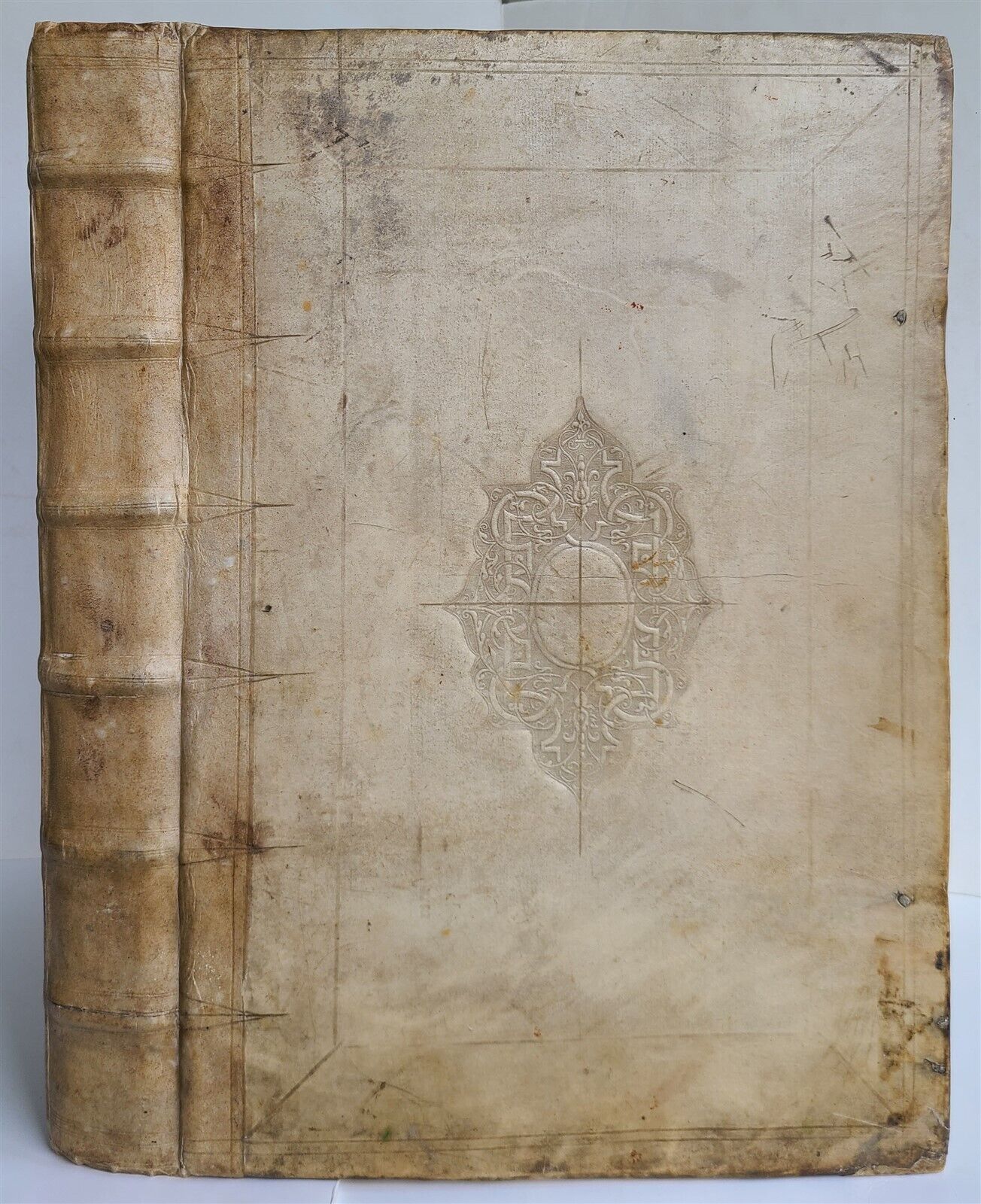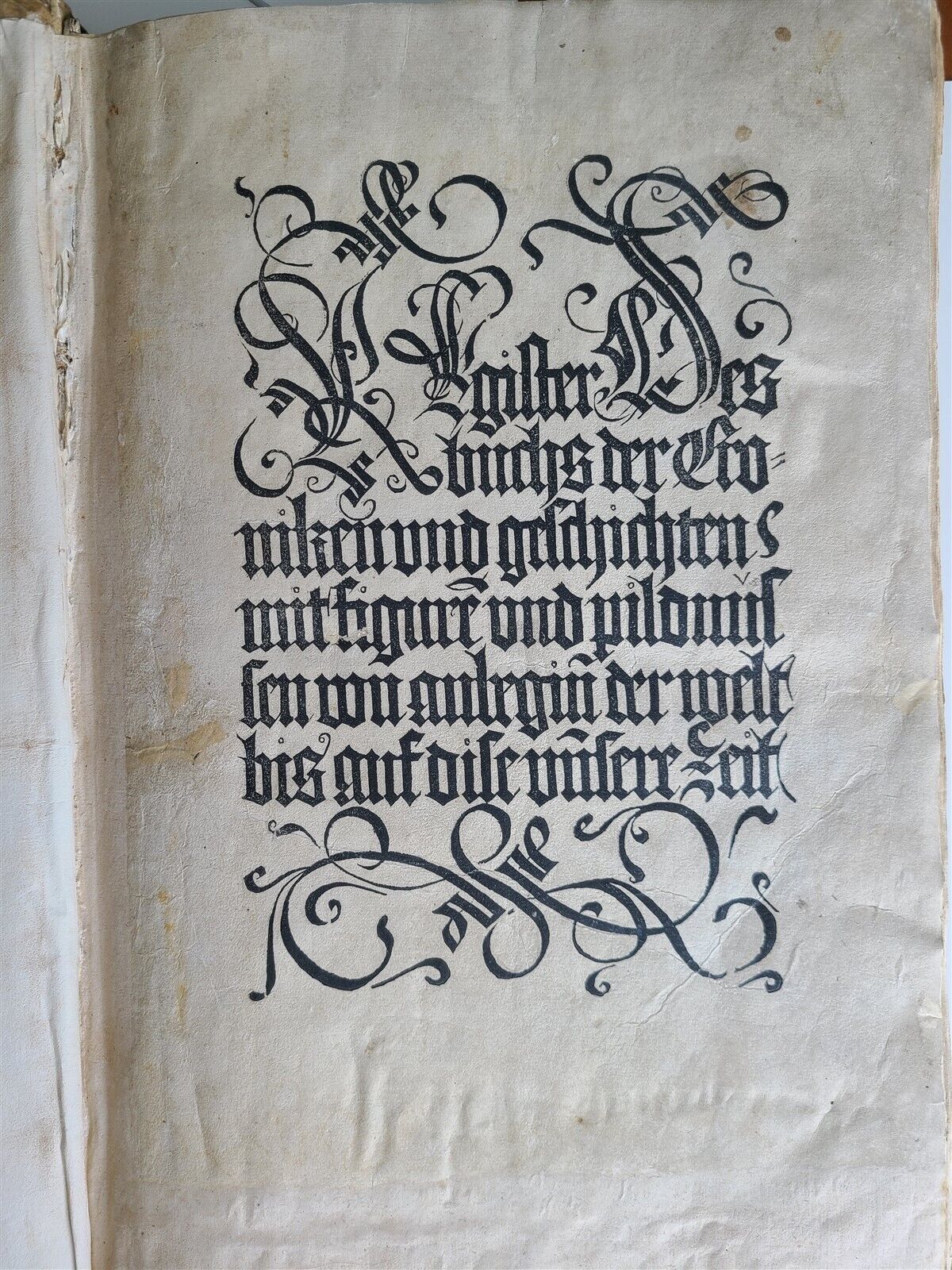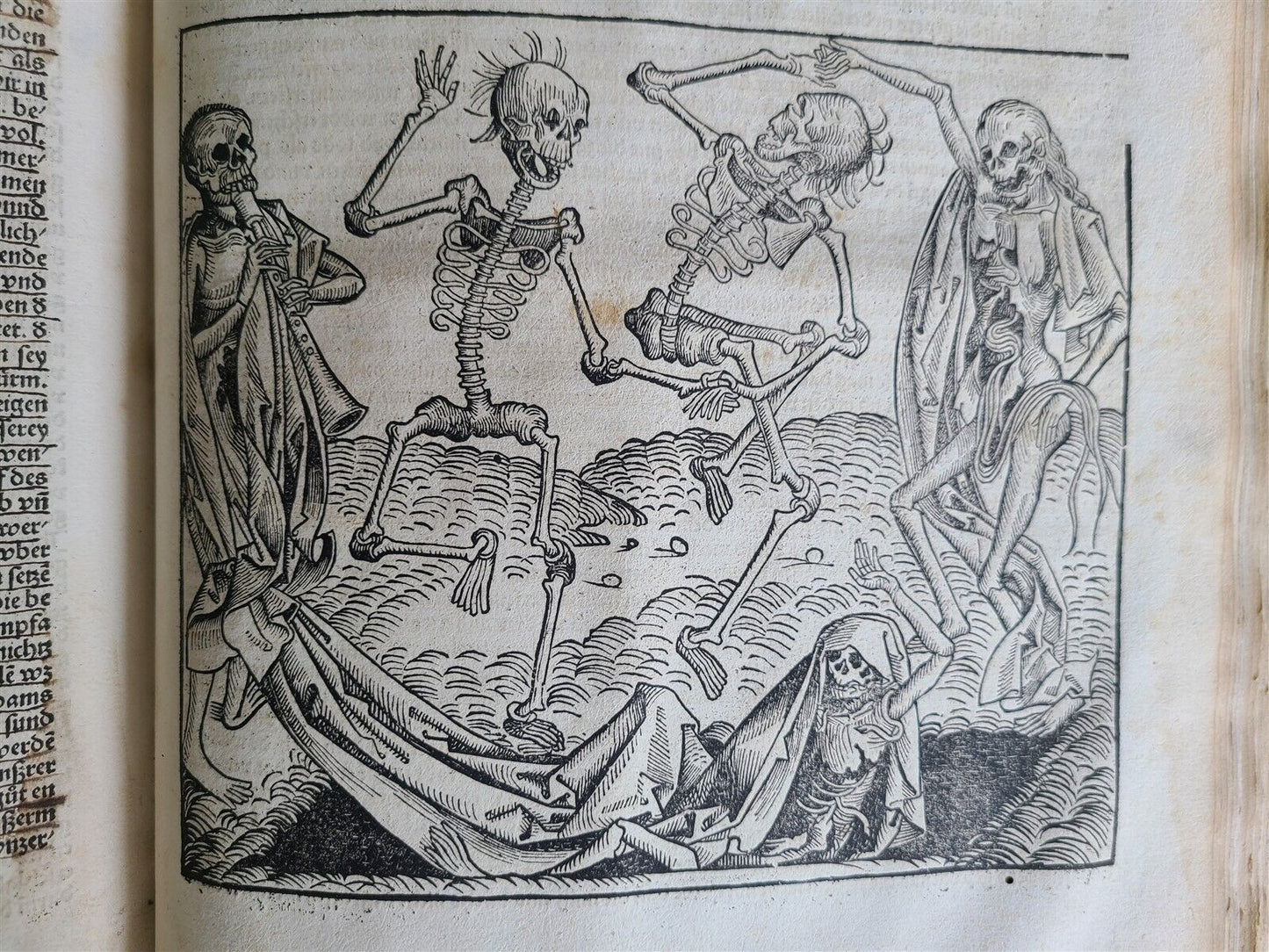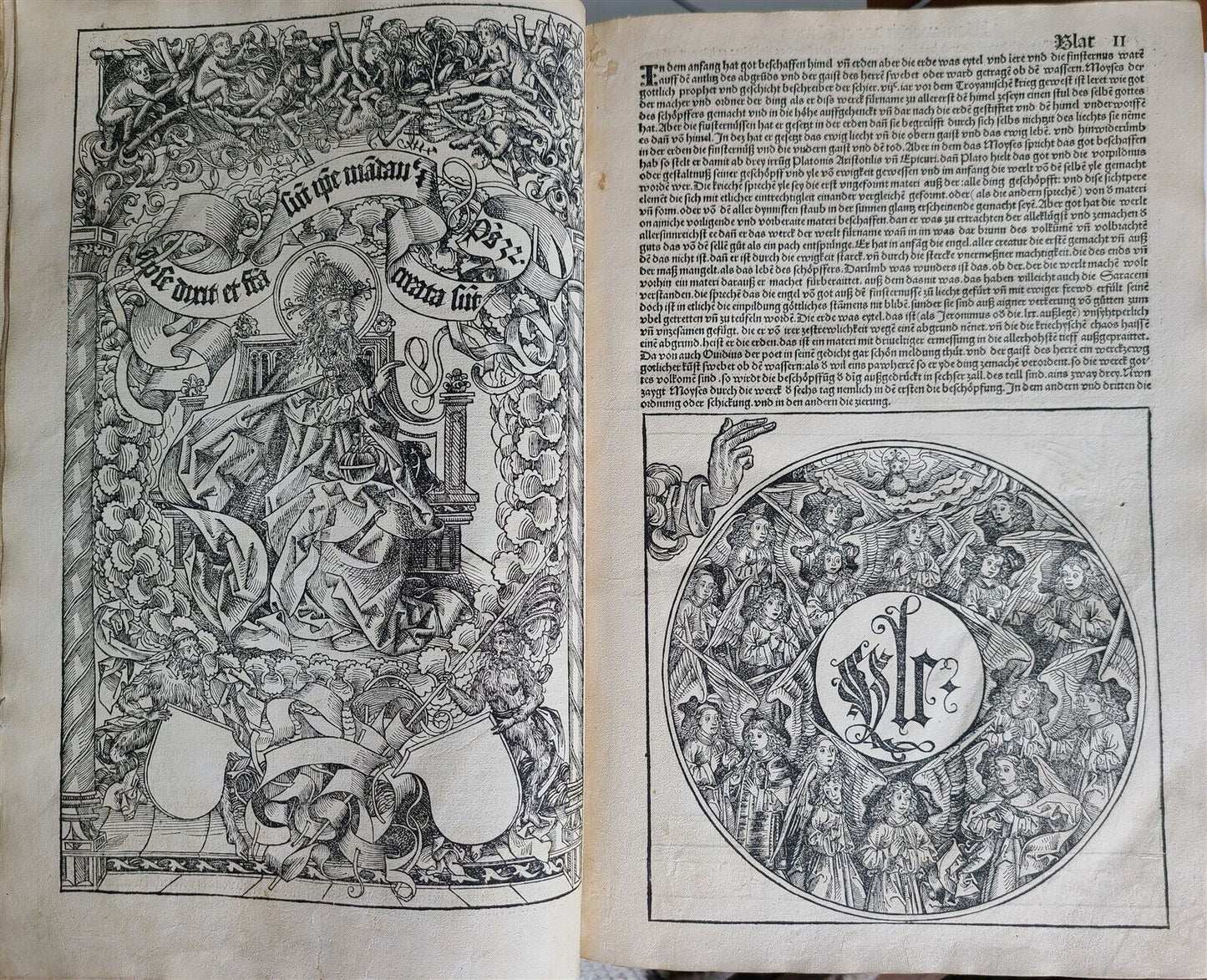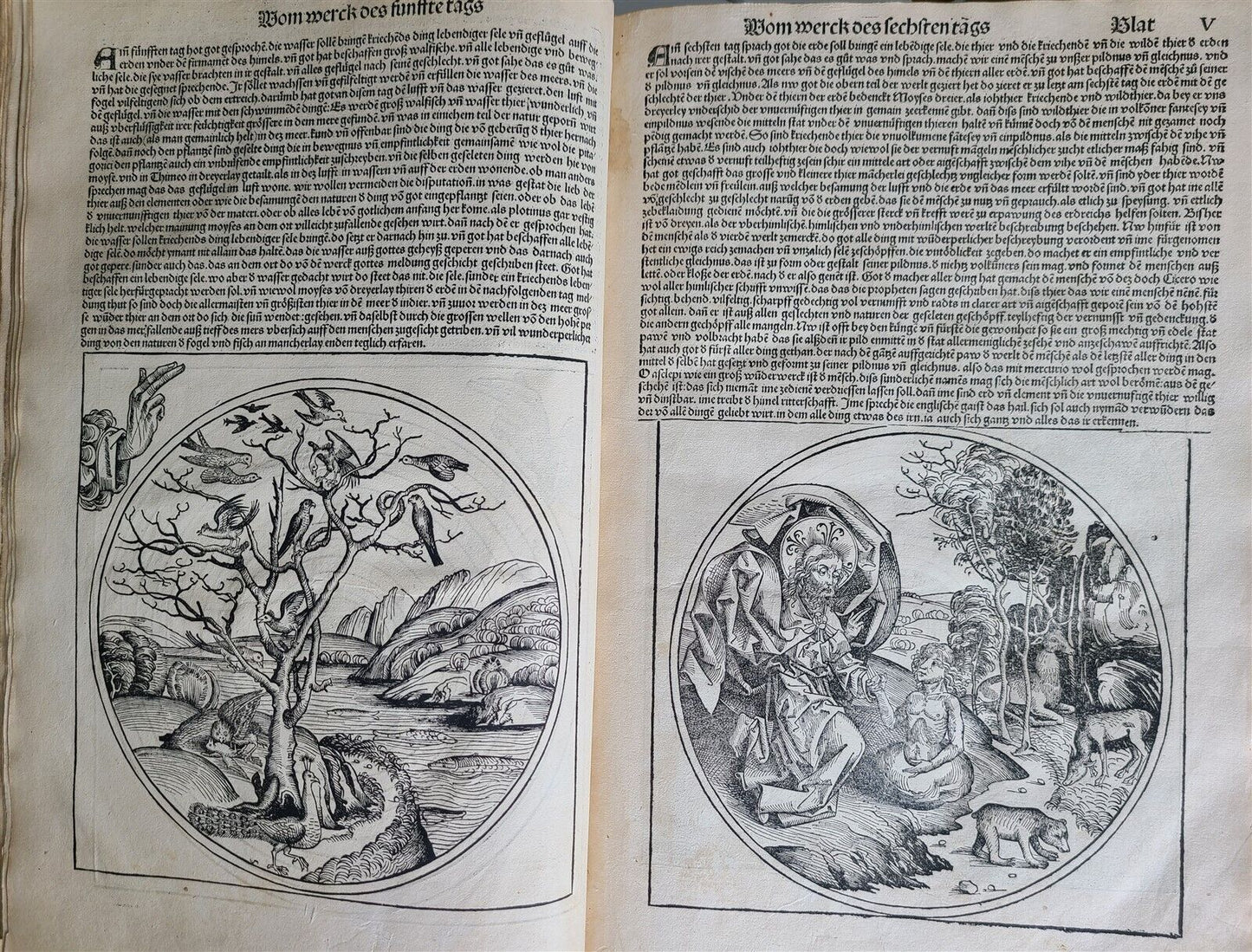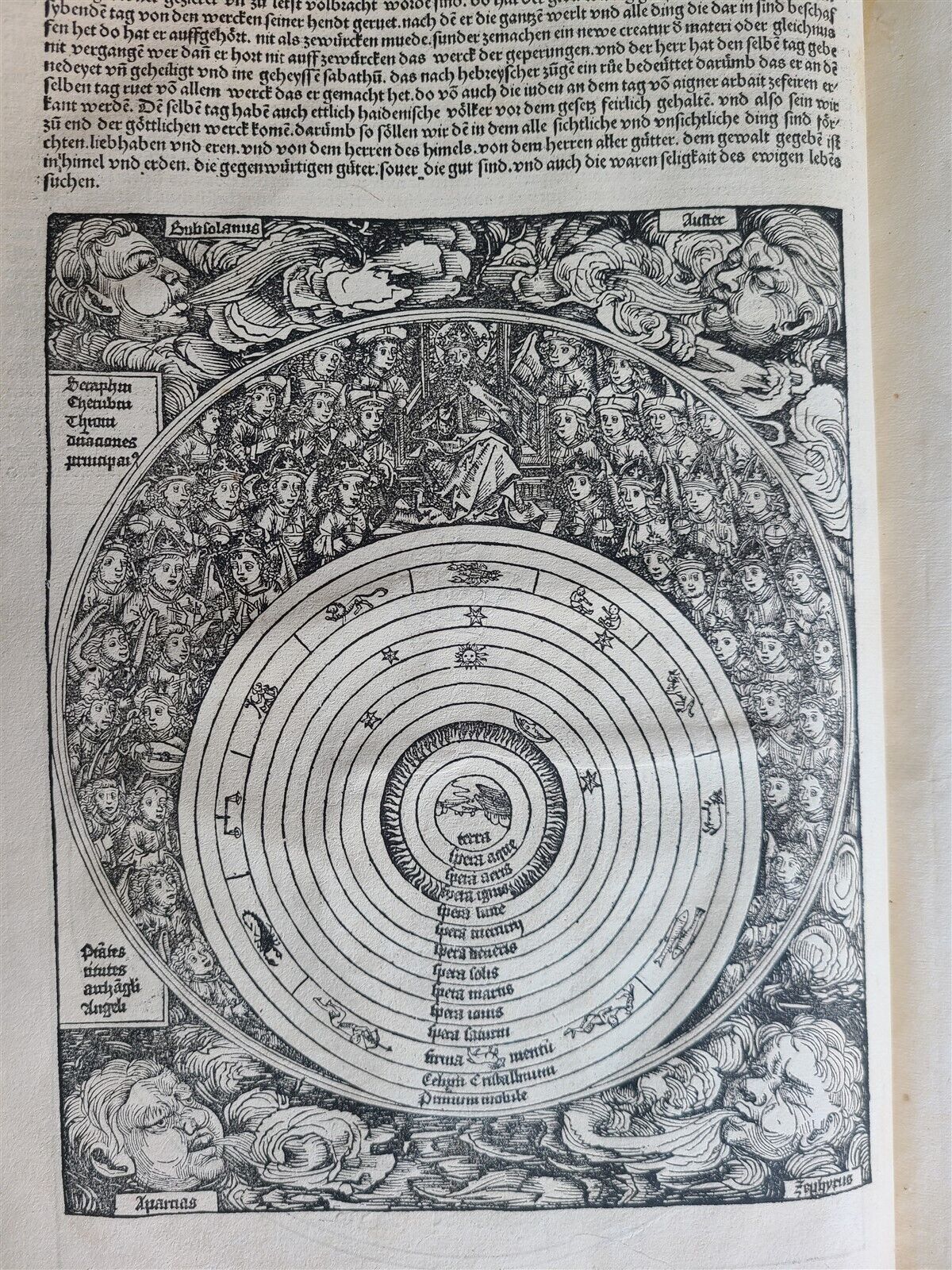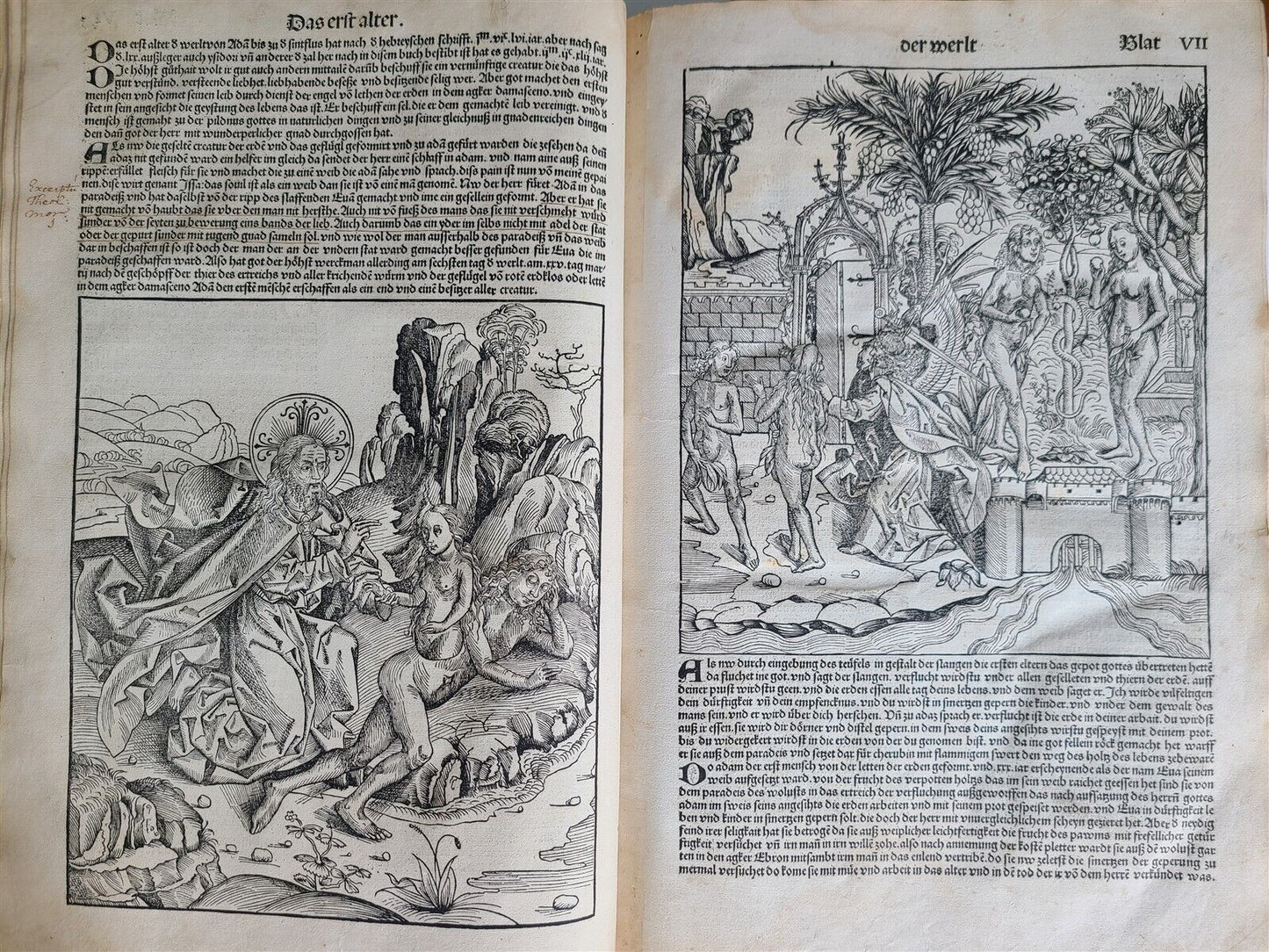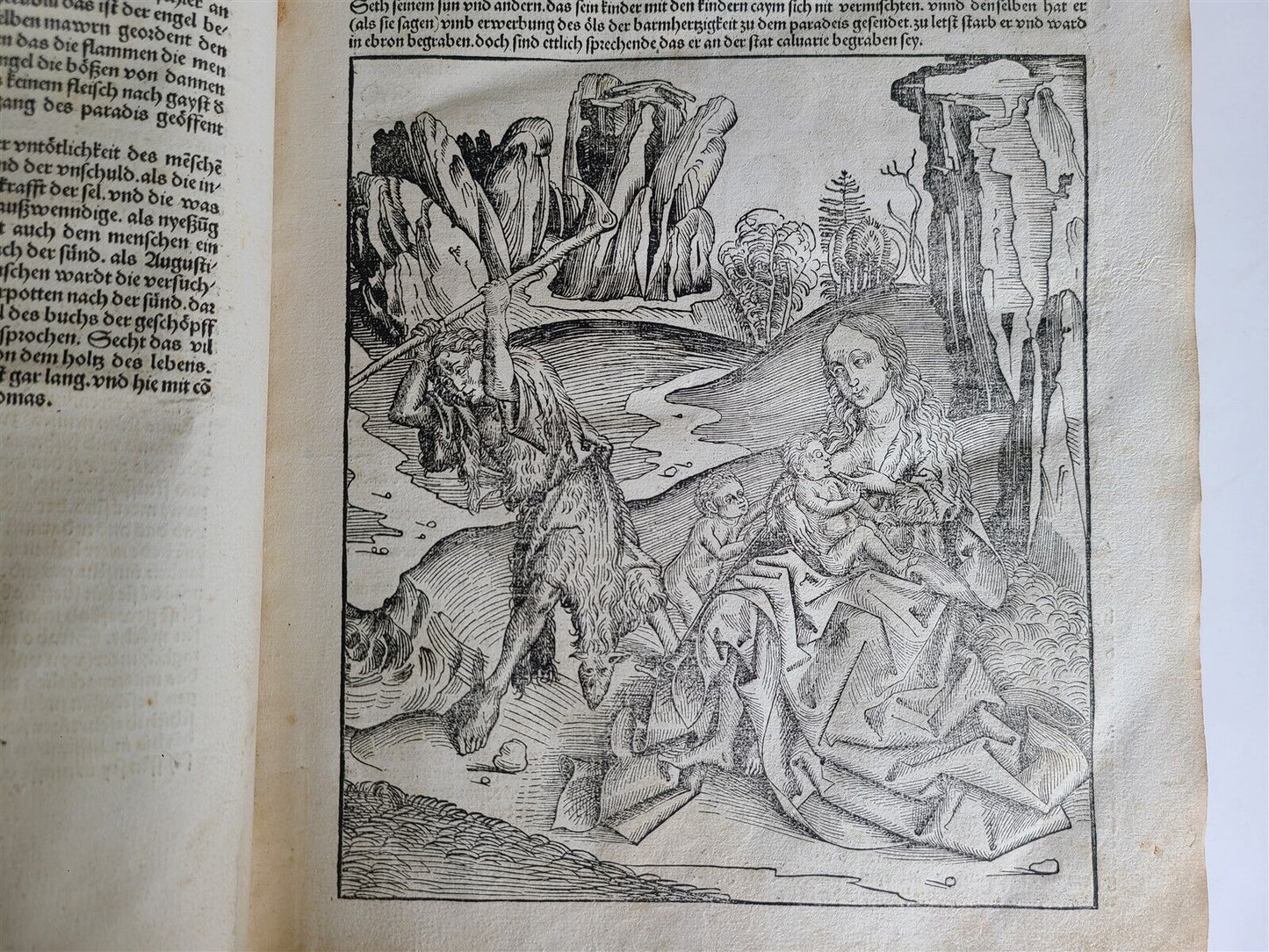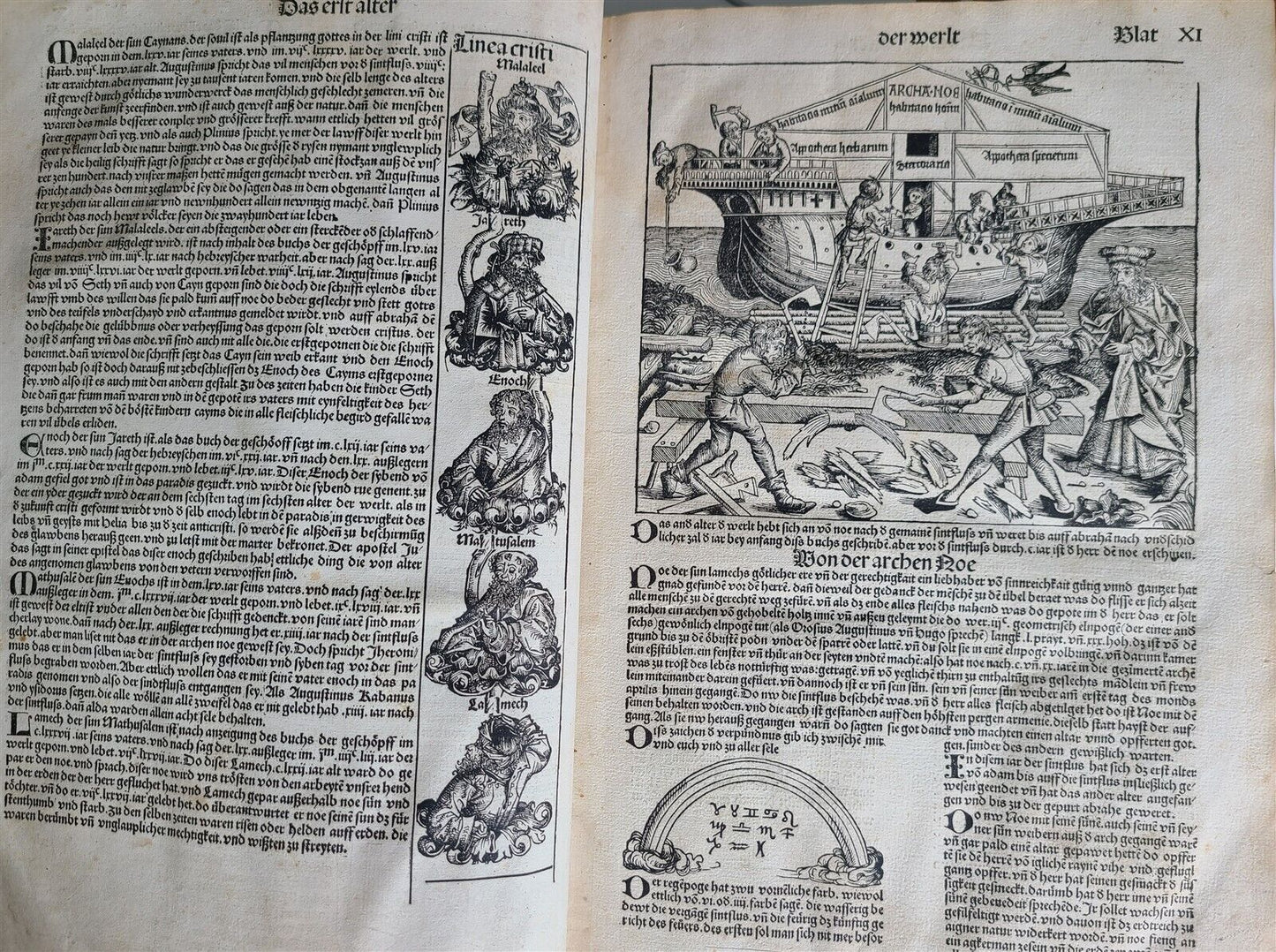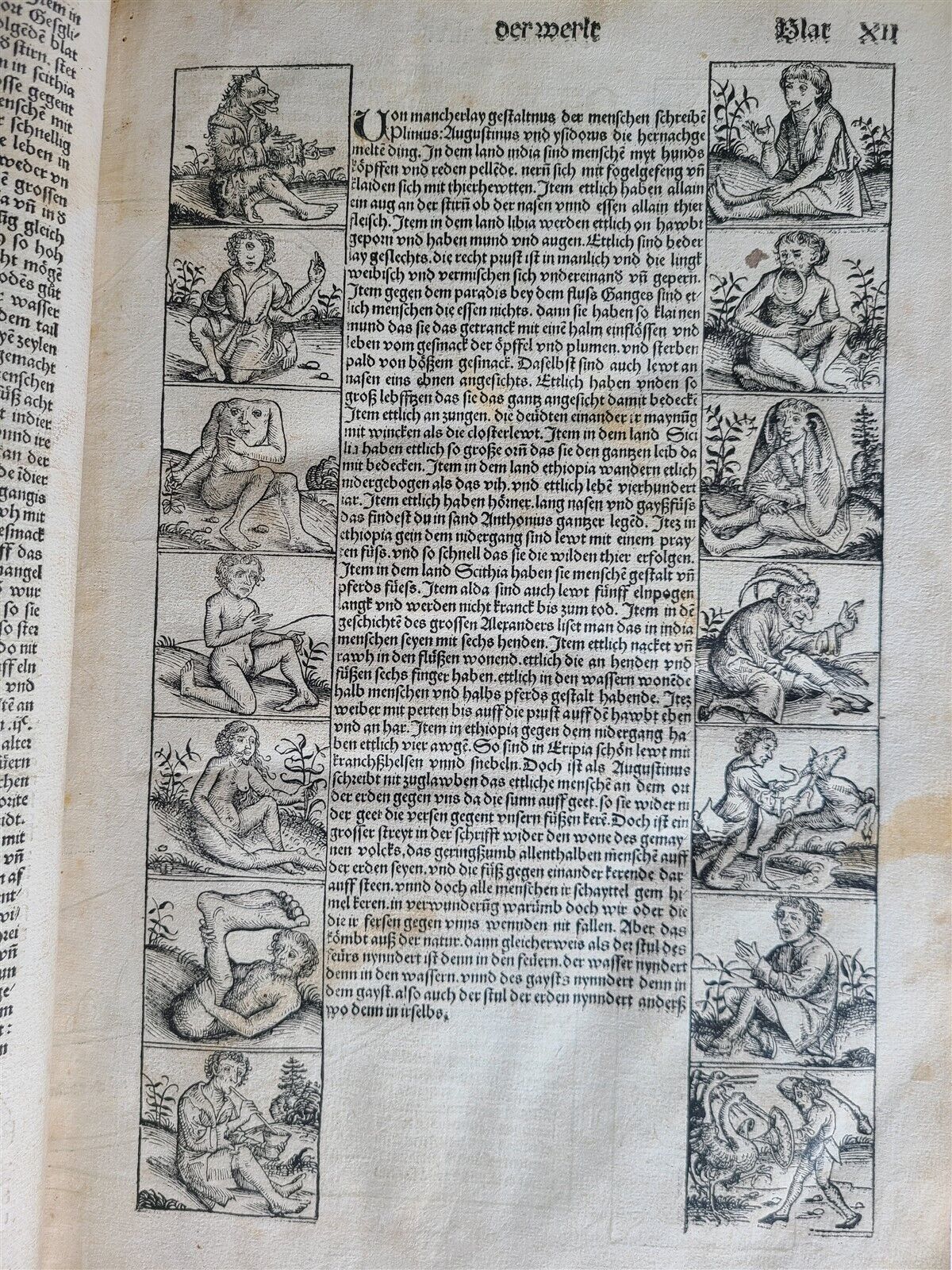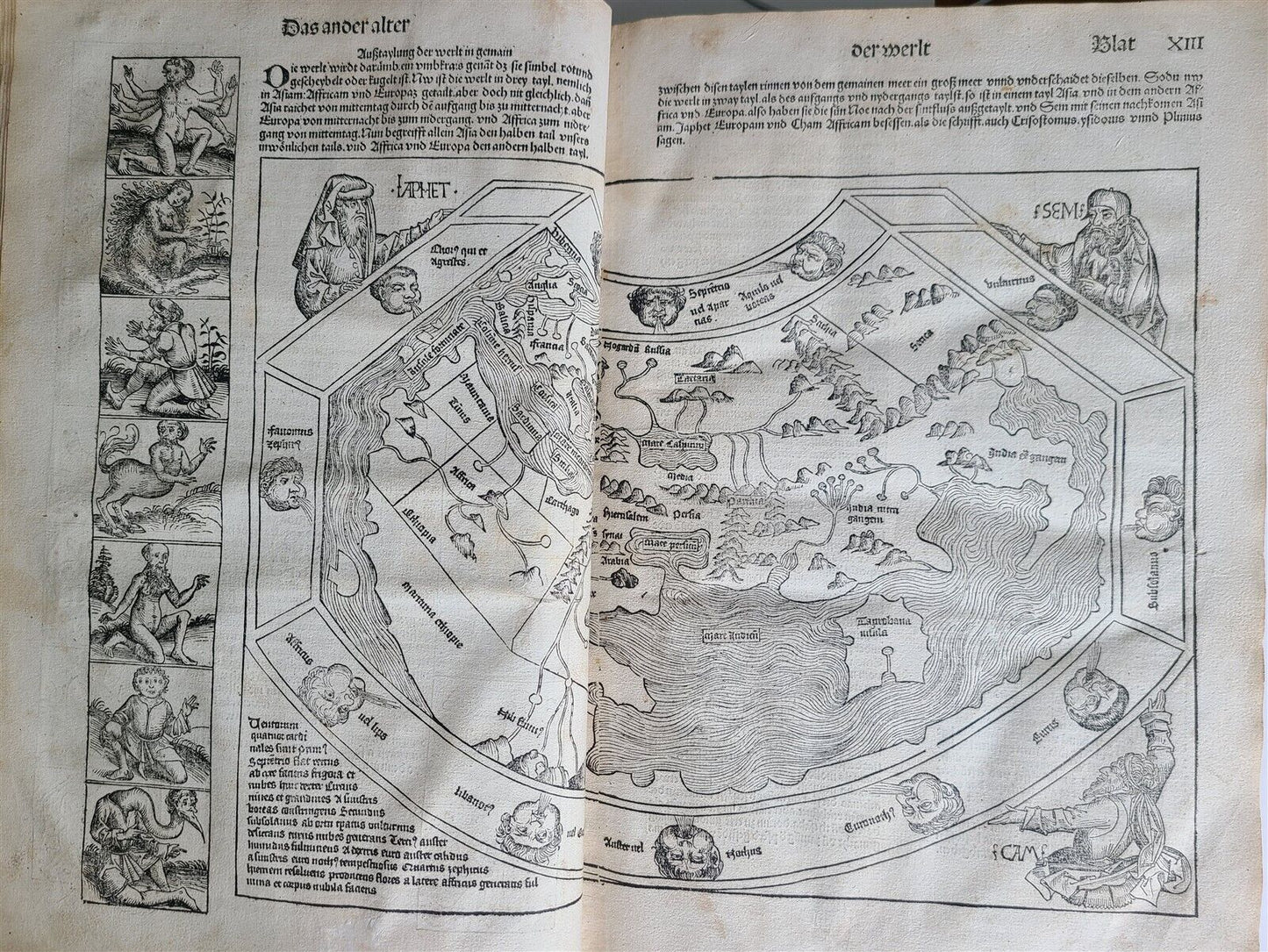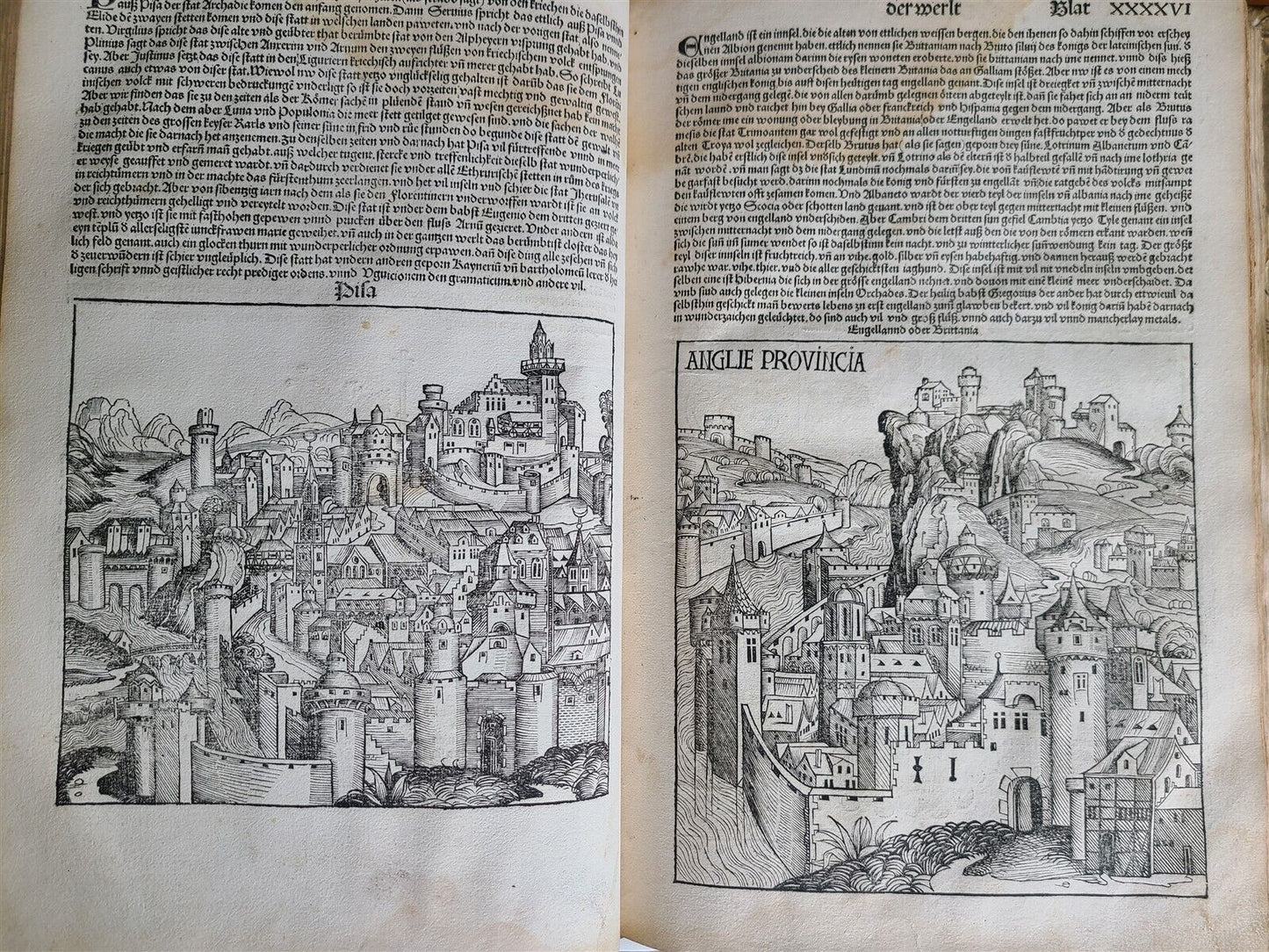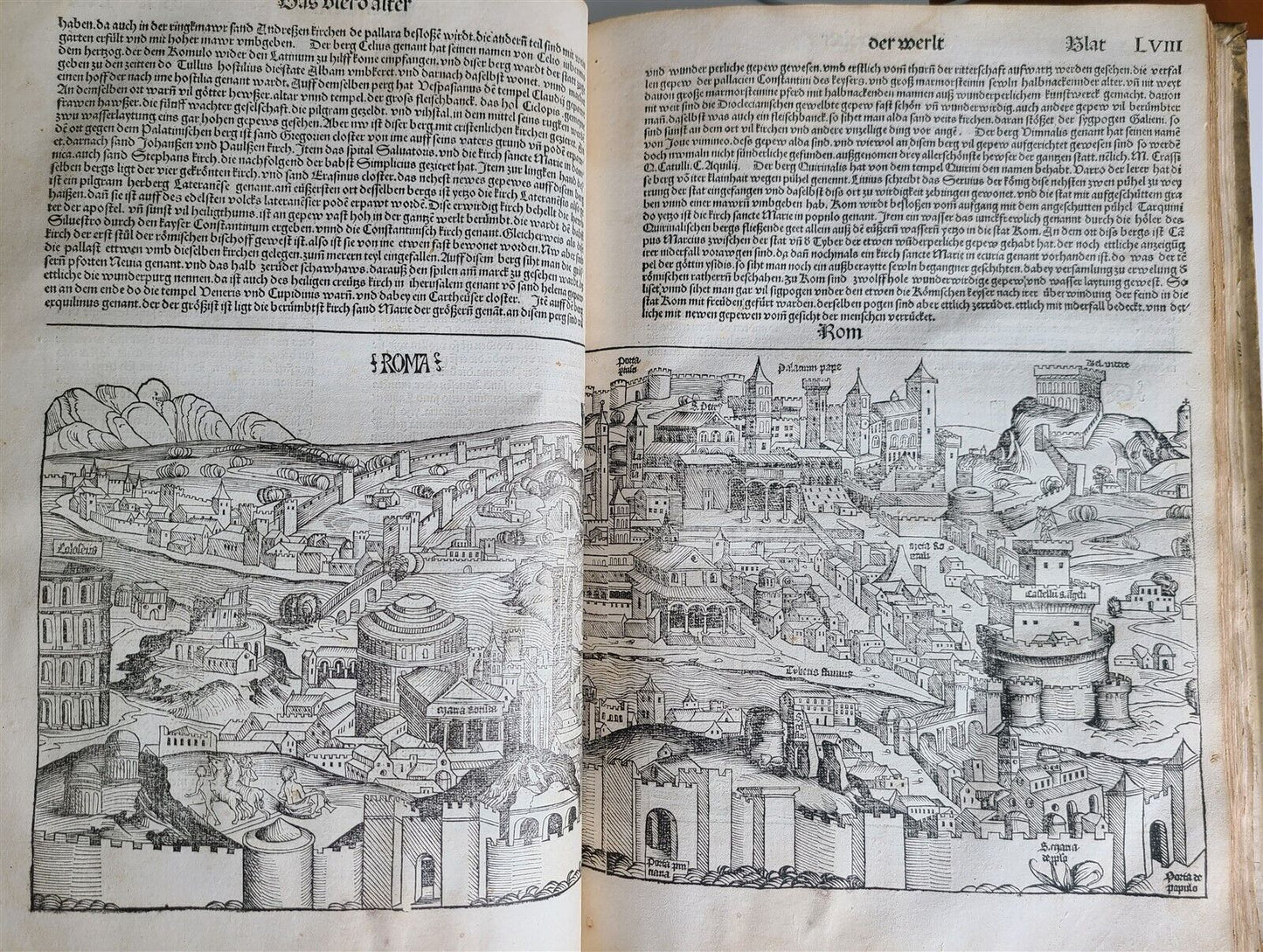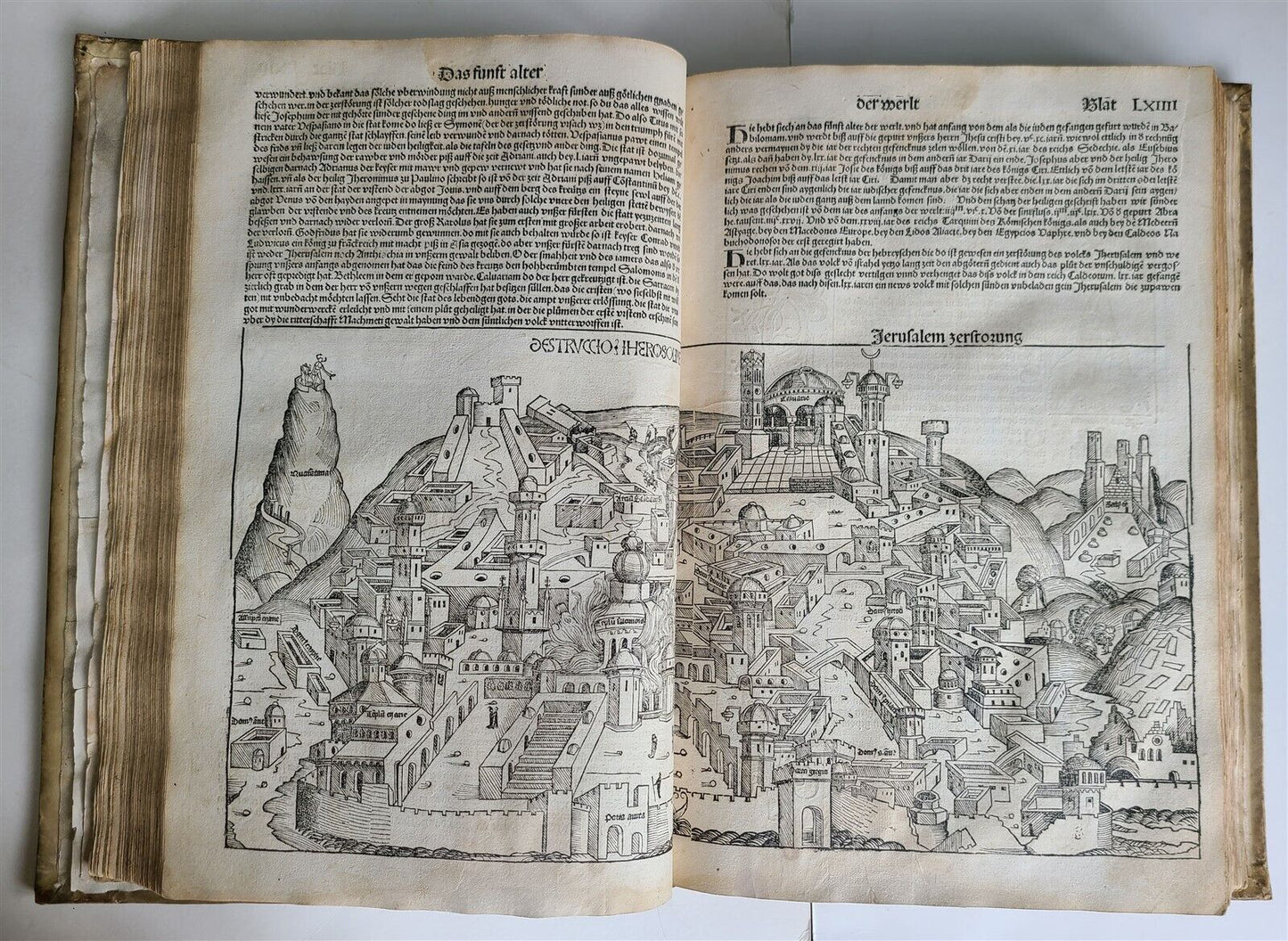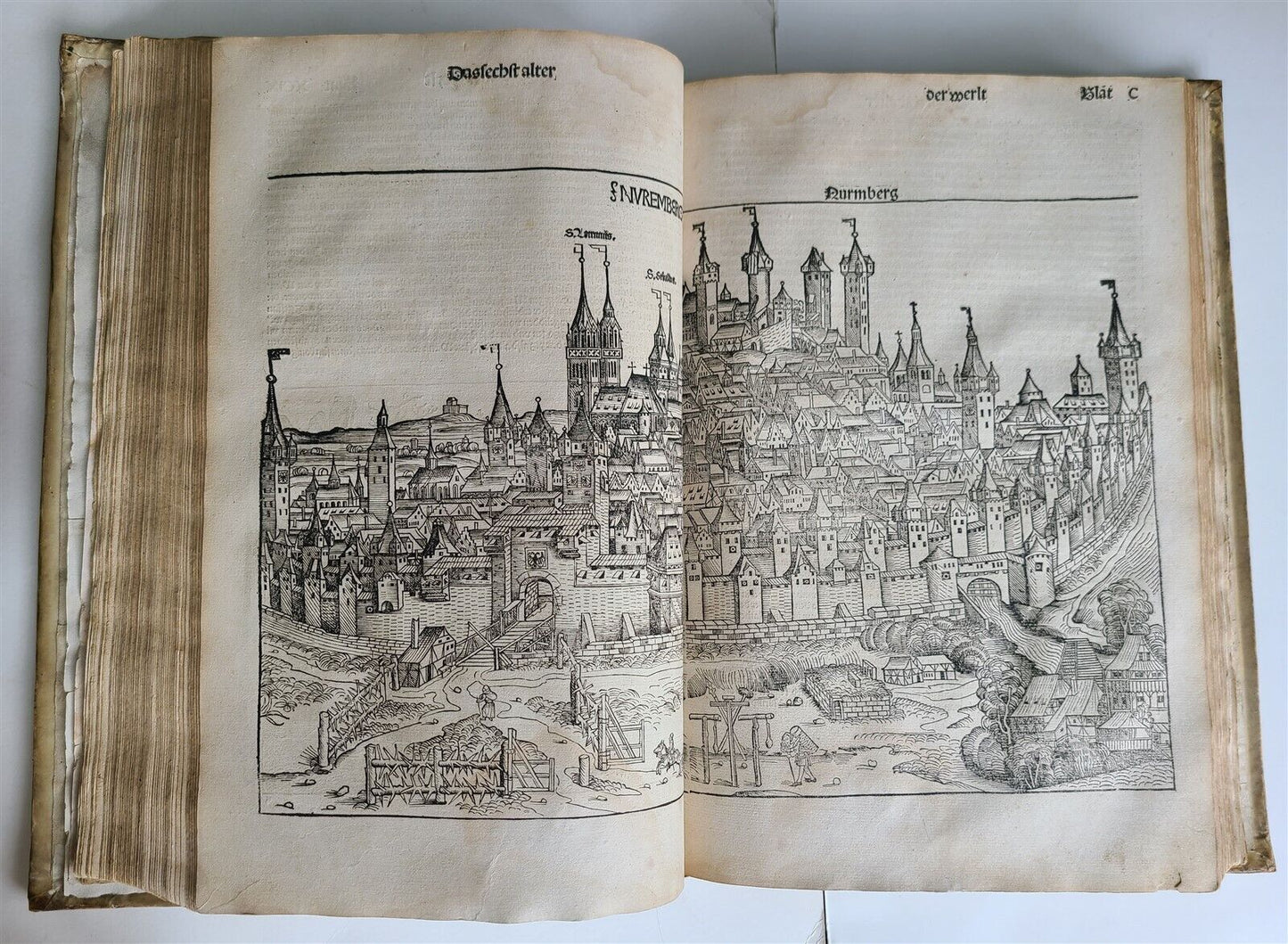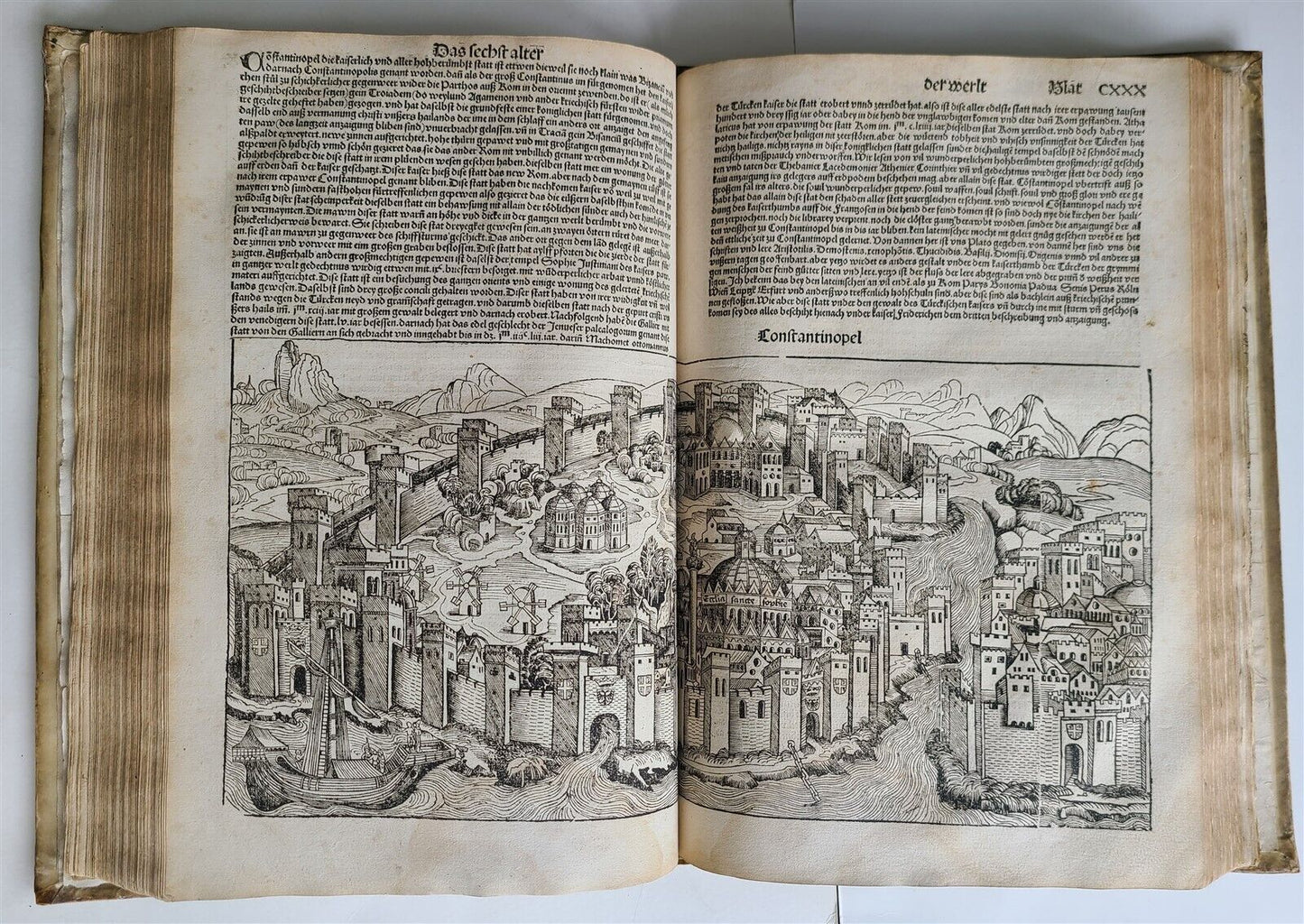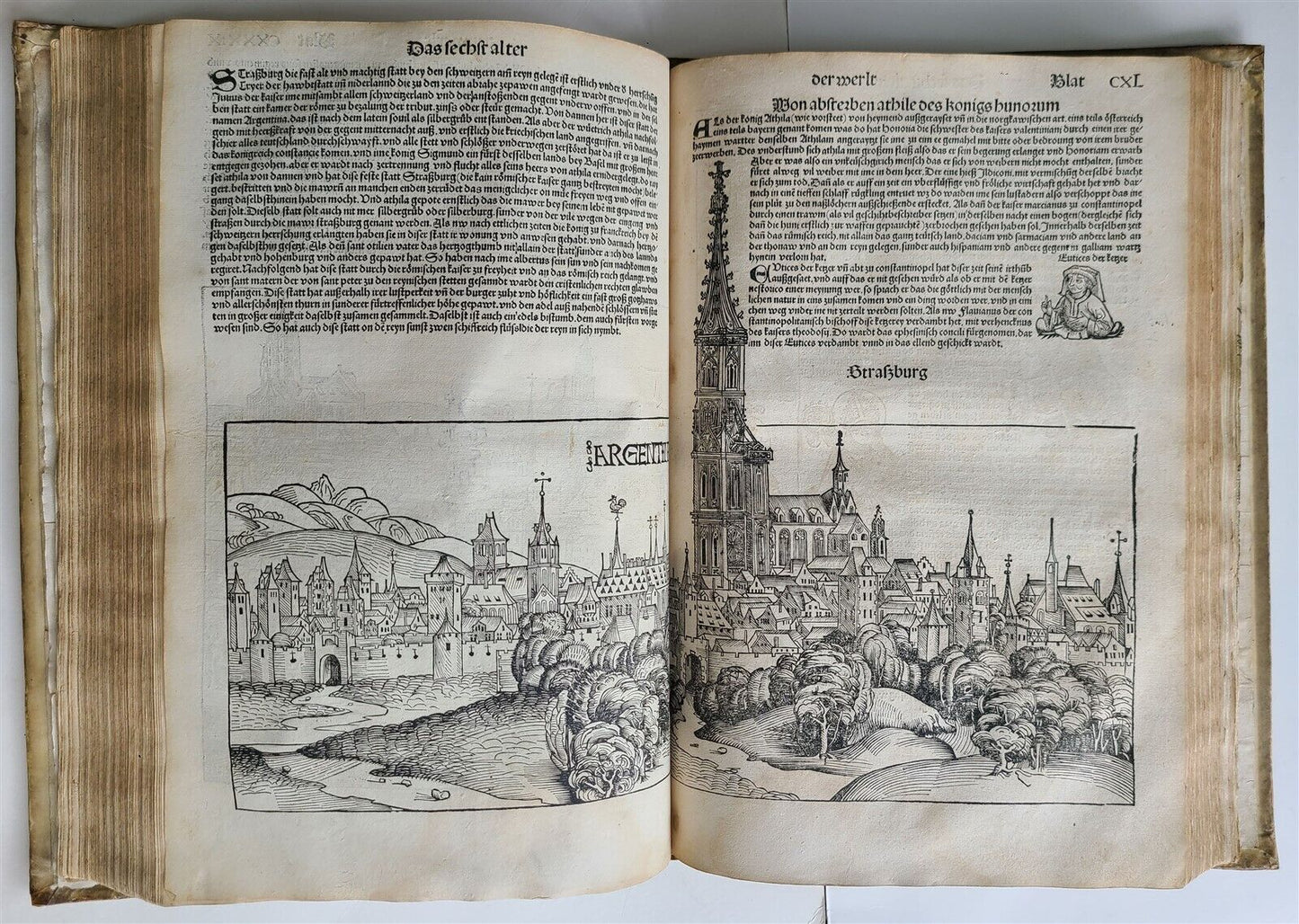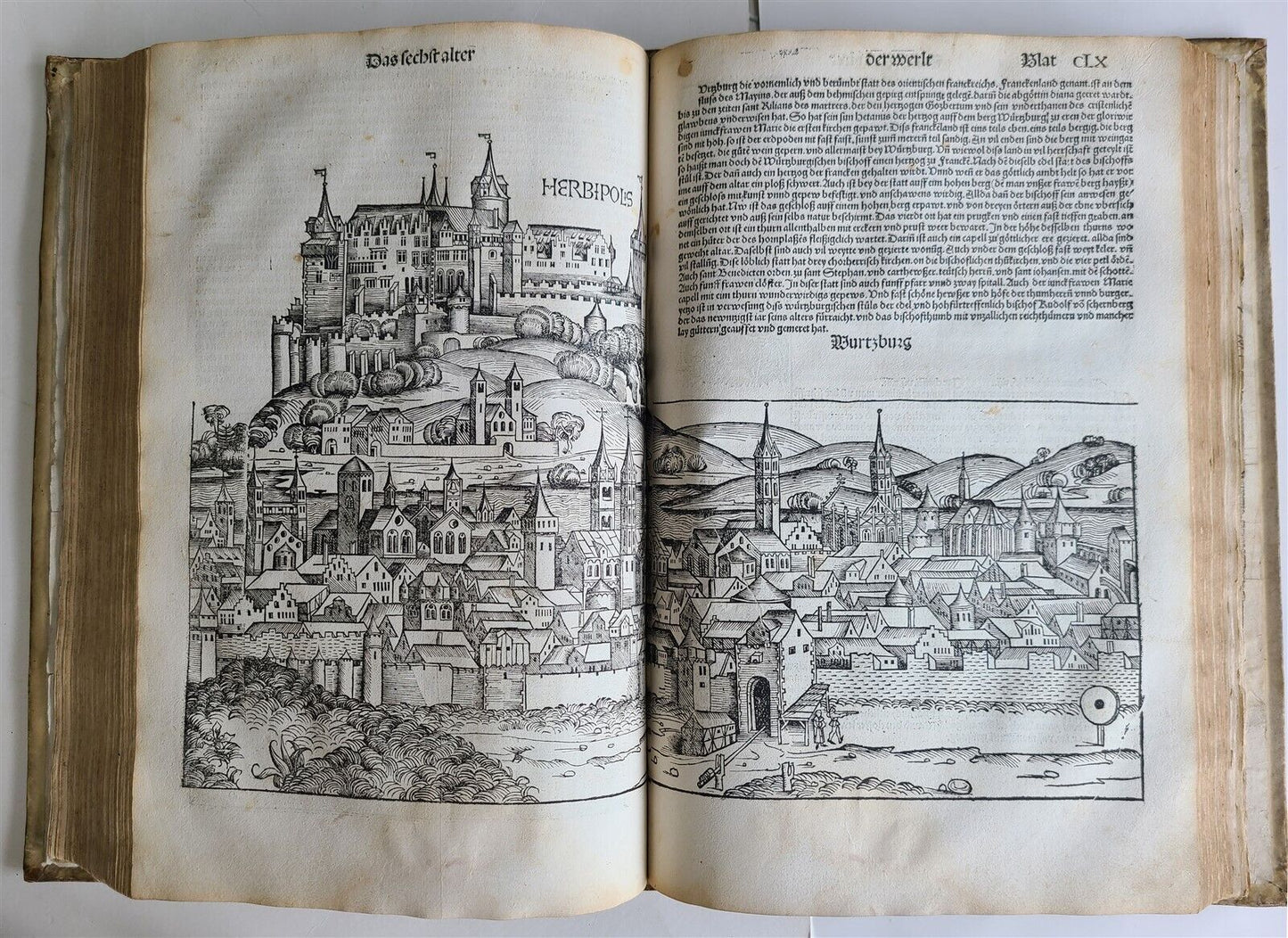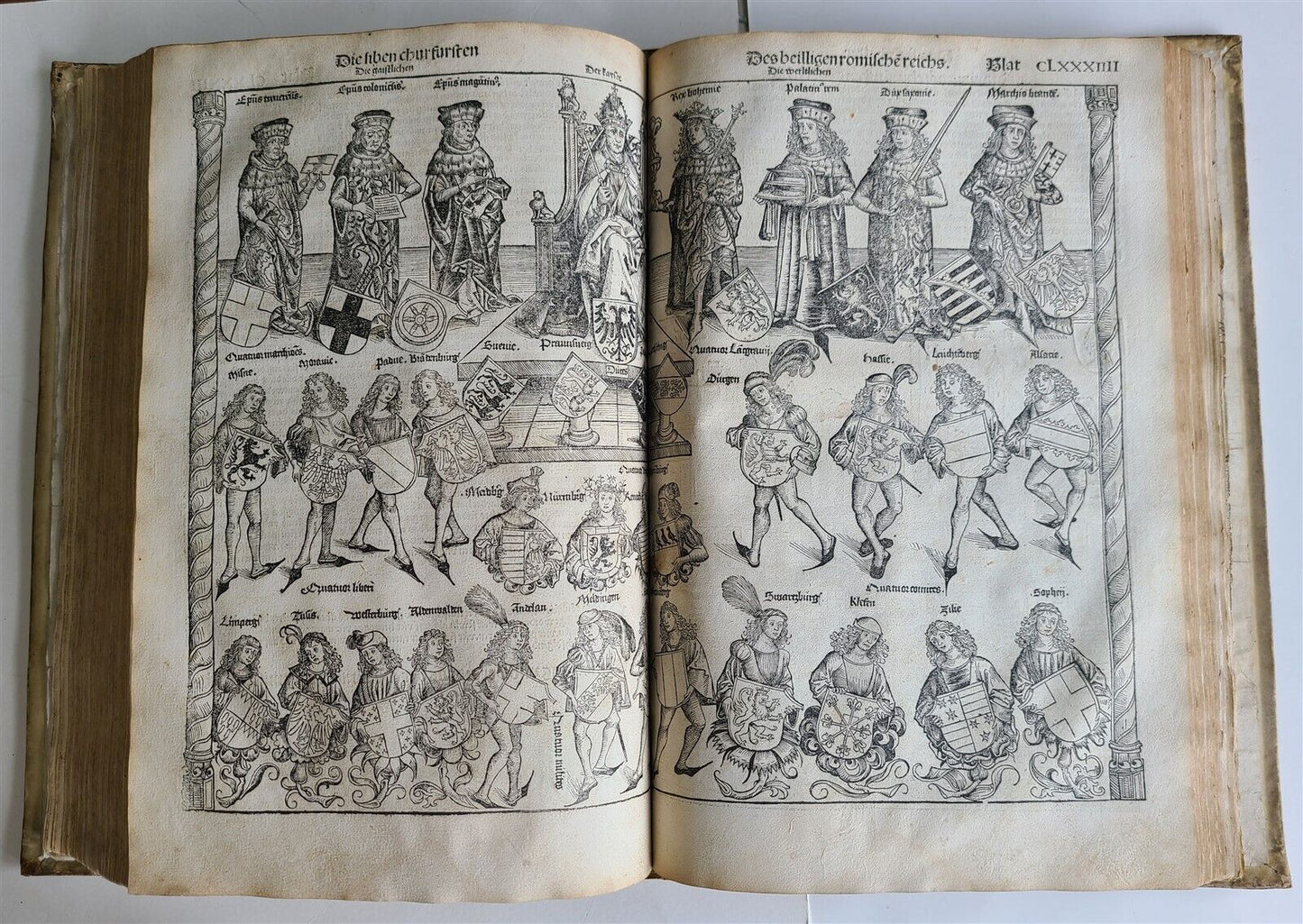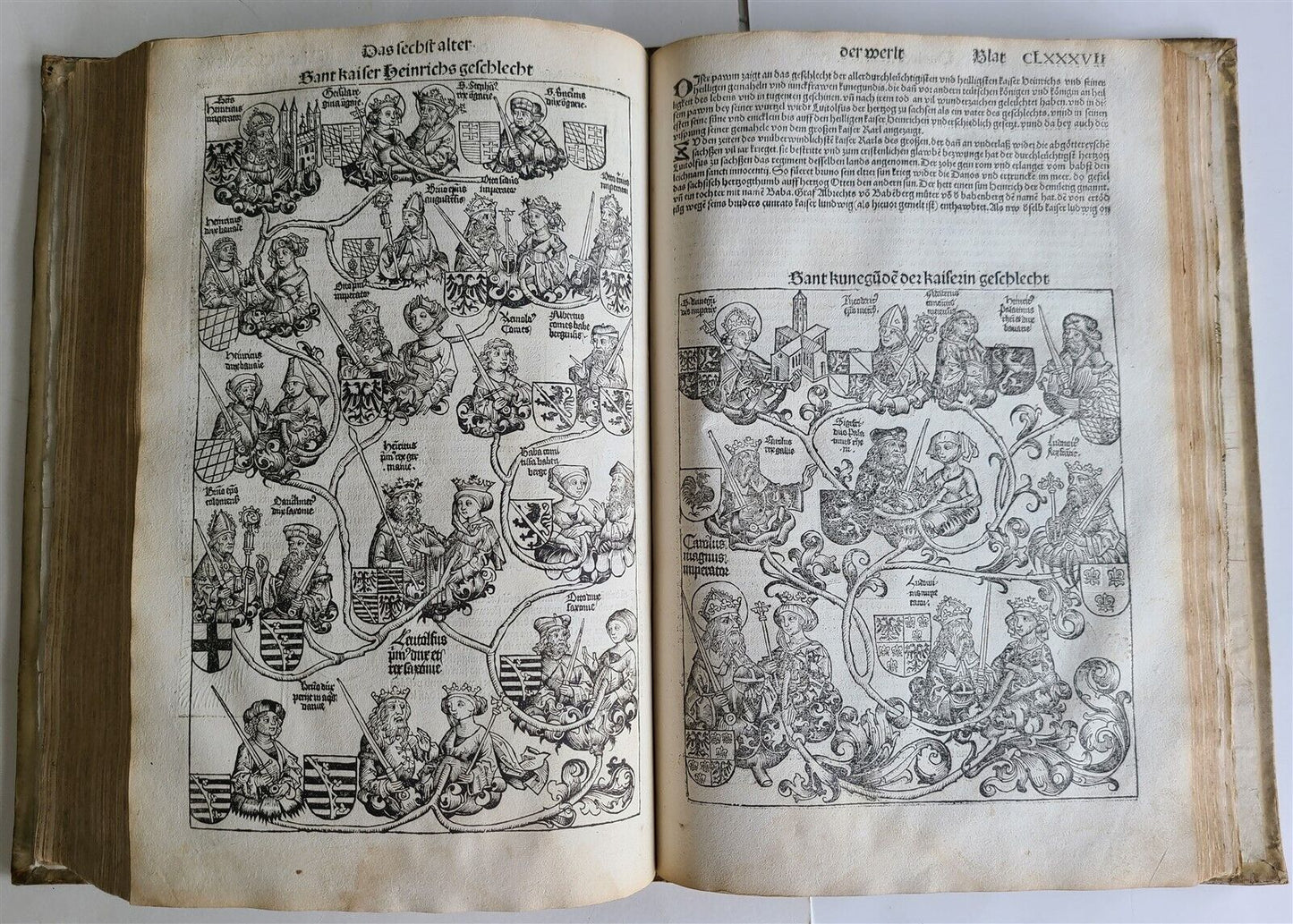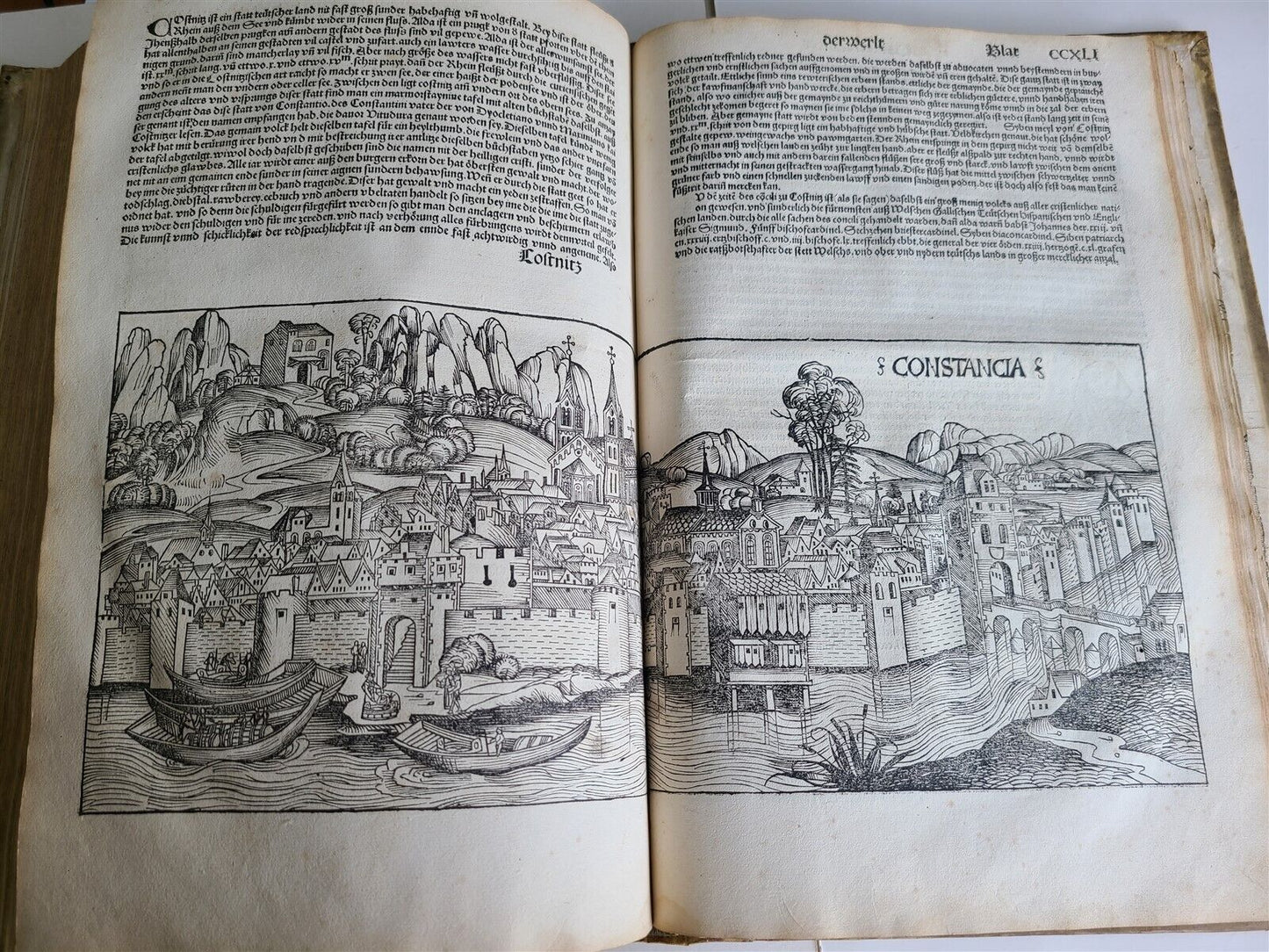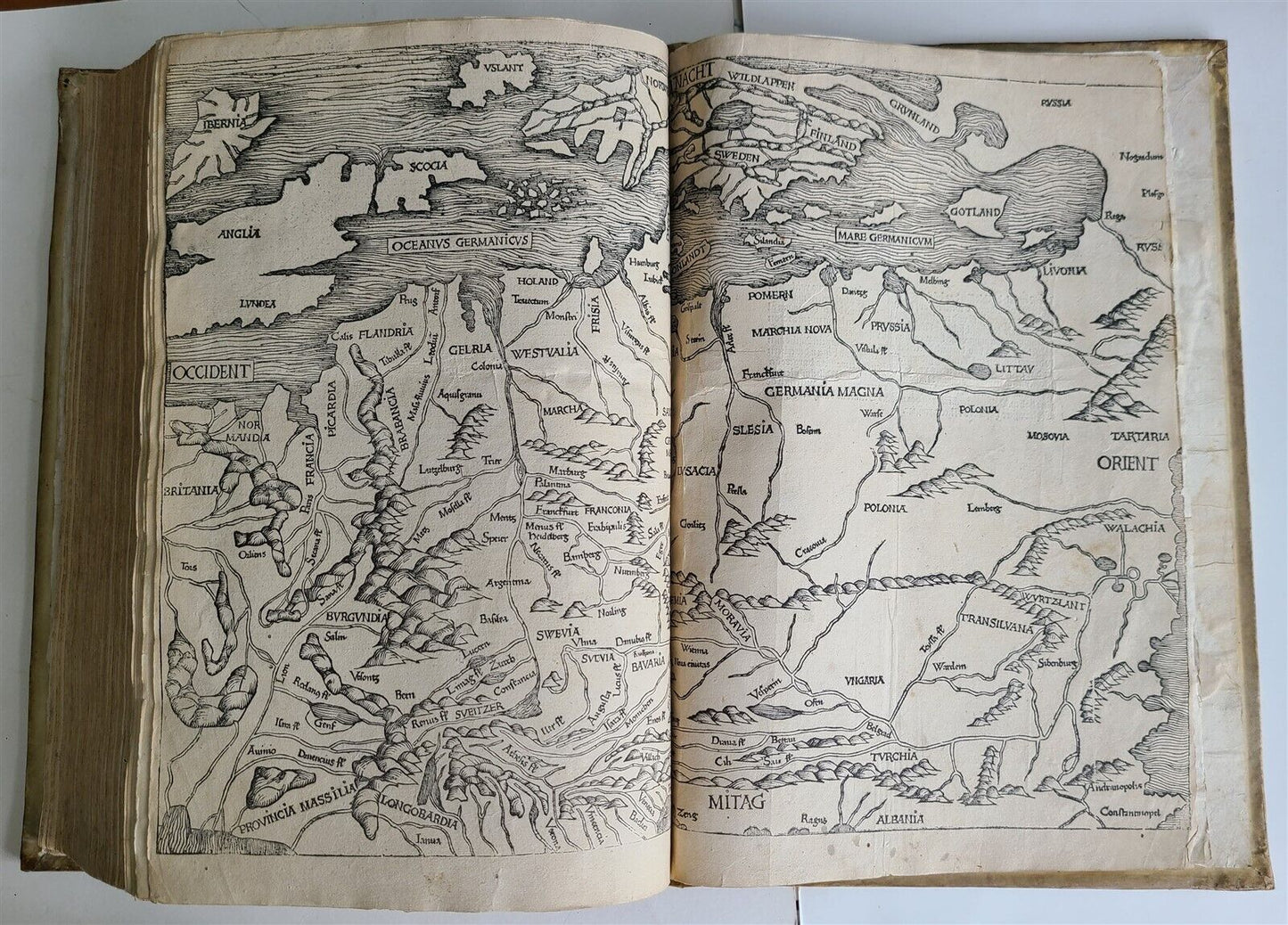Motka
1493 NUREMBERG CHRONICLE antique INCUNABULA Liber chronicarum HARTMANN SCHEDEL
1493 NUREMBERG CHRONICLE antique INCUNABULA Liber chronicarum HARTMANN SCHEDEL
Regular price
$77,000.00 USD
Regular price
$110,000.00 USD
Sale price
$77,000.00 USD
Unit price
per
Couldn't load pickup availability
img{max-width:100%}
NUREMBERG CHRONICLE
SCHEDEL, HARTMANN (1440-1514)
Liber chronicarum
[in German: Das Buch der Croniken und Geschichten.]
Nuremberg: Anton Koberger for Sebald Schreyer and Sebastian Kammermeister, 23 December 1493
Imperial folio (427 x 290 mm)
297 leaves (of 298, without final blank).
59-64 lines and headline, table and parts of the text in two columns.
Types: 24:111G (text), 9:165G (headlines), xylographic title and c. 1809 woodcut illustrations printed from 645 blocks by Michael Wolgemut, Wilhelm Pleydenwurff and their workshop, including Albrecht Durer
comprising 29 double-page town views,
8 full-page woodcuts and double-page maps of the World and of Europe by Hieronymus Munzer after Nicolas Khrypffs
17th-century Dutch vellum stamped with large central arabesque, rebacked in style.
Some browning and staining, xylographic title remargined and laid down,
a few leaves with marginal repairs (including first index leaf)
and large tear affecting image to leaf 268,
about 30 leaves with short minor marginal tears or minor worming,
leaf 188 with a few words in three lines erased.
Provenance: A few leaves with early ink marginalia.
FIRST EDITION IN GERMAN of the Nuremberg Chronicle, printed in the same year as the Latin edition. The German and Latin editions were planned simultaneously, with the German edition of Georg Alt's translation appearing five months after the Latin edition. The of the most extensively illustrated book of the 15th century.
The 29 large double-page city views, many illustrated for the first time, are accurate in depicting distinguished features of each city.
In addition, it includes many details of 15th-century daily life:
carpenters with their tools, astronomers and their instruments, a chess player, archers, bridges, derricks, dishes, furniture, windmills, ships, beds, houses, fortifications, weapons, tents, wharves, ferries, books, drawing materials, dogs, horses, and other animals, as well as costumes.
Hartmann Schedel's Nuremberg Chronicle epitomizes "the commercial sophistication, economic power and technical virtuosity that brought the art of print to this extraordinary climax" (Pettegree).
Reference:
BMC II 437;
BSB-Ink. S-197;
Bod-Inc. S-110;
Goff S-309;
GW M40796;
HC *14510;
Pettegree, The Book in the Renaissance, New Haven, 2011 p 42; Reske,
The Production of Schedel's Nuremberg Chronicle Wiesbaden, 2000;
Ellen Shaffer The Nuremberg Chronicle, Los Angeles, 1950;
Wilson, The Making of the Nuremberg Chronicle Amsterdam, 1976.
=====================================
PAYMENT WITH BANK TRANSFER or CERTIFIED CHECK
=====================================
From Wikipedia:
Illustrator Michael Wolgemut and Wilhelm Pleydenwurff
Subject History of the world
Published 1493, by Anton Koberger
The Nuremberg Chronicle is an illustrated encyclopedia consisting of world historical accounts, as well as accounts told through biblical paraphrase.
Subjects include human history in relation to the Bible, illustrated mythological creatures, and the histories of important Christian and secular cities from antiquity.
Finished in 1493, it was originally written in Latin by Hartmann Schedel, and a German version was translated by Georg Alt.
It is one of the best-documented early printed books—an incunabulum—and one of the first to successfully integrate illustrations and text.
Latin scholars refer to it as the Liber Chronicarum (Book of Chronicles) as this phrase appears in the index introduction of the Latin edition. English-speakers have long referred to it as the Nuremberg Chronicle after the city in which it was published. German-speakers refer to it as Schedelsche Weltchronik (Schedel's World History) in honour of its author.
Woodcut from 1493 depicting the burning of Jews in the 14th century, today in the Jewish Museum of Switzerland in Basel
Two Nuremberg merchants, Sebald Schreyer (1446–1503) and his son-in-law, Sebastian Kammermeister (1446–1520), commissioned the Latin version of the chronicle on 29 December 1491.
They also commissioned Georg Alt (1450–1510), a scribe at the Nuremberg treasury, to translate the work into German. Both Latin and German editions were printed by Anton Koberger in Nuremberg.
Contracts were recorded by scribes, bound into volumes, and deposited in the Nuremberg City Archives.
The first contract, from December 1491, established the relationship between the illustrators and the patrons.
The painters, Wolgemut and Pleydenwurff, were to provide the layout of the chronicle, to oversee the production of the woodcuts, and to guard the designs against piracy. The patrons agreed to advance 1,000 gulden for paper, printing costs, and the distribution and sale of the book. A second contract between the patrons and the printer was executed in March 1492. It stipulated conditions for acquiring the paper and managing the printing. The blocks and the archetype were to be returned to the patrons once the printing was completed.
The author of the text, Hartmann Schedel, was a medical doctor, humanist, and book collector. He earned a doctorate in medicine in Padua in 1466, then settled in Nuremberg to practice medicine and collect books. According to an inventory done in 1498, Schedel's personal library contained 370 manuscripts and 670 printed books. The author used passages from the classical and medieval works in this collection to compose the text of the chronicle. He borrowed most frequently from another humanist chronicle, the Supplementum Chronicarum by Giacomo Filippo Foresti of Bergamo. It has been estimated that about 90% of the text is pieced together from works on humanities, science, philosophy, and theology, while about 10% of the chronicle is Schedel's original composition.
Nuremberg was one of the largest cities in the Holy Roman Empire in the 1490s, with a population of between 45,000 and 50,000. Thirty-five patrician families composed the City Council. The Council controlled all aspects of printing and craft activities, including the size of each profession and the quality, quantity, and type of goods produced. Although dominated by a conservative aristocracy, Nuremberg was a centre of northern humanism. Anton Koberger, printer of the Nuremberg Chronicle, printed the first humanist book in Nuremberg in 1472. Sebald Shreyer, one of the patrons of the chronicle, commissioned paintings from classical mythology for the grand salon of his house. Hartmann Schedel, author of the chronicle, was an avid collector of both Italian Renaissance and German humanist works. Hieronymus Münzer, who assisted Schedel in writing the chronicle's chapter on geography, was among this group, as were Albrecht Dürer and Johann and Willibald Pirckheimer.
The Chronicle was first published in Latin on July 12, 1493 in the city of Nuremberg. This was quickly followed by a German translation on December 23, 1493. An estimated 1,400 to 1,500 Latin and 700 to 1,000 German copies were published. A document from 1509 records that 539 Latin versions and 60 German versions had not been sold.
Approximately 400 Latin and 300 German copies survived into the twenty-first century.
They are scattered around the world in museums and collections.
The larger illustrations were also sold separately as prints, often hand-tinted in watercolour.
Many copies of the book are coloured, with varying degrees of skill; there were specialist shops for this. The colouring on some examples has been added much later, and some copies have been broken up for sale as decorative prints.
The publisher and printer was Anton Koberger, the godfather of Albrecht Durer, who, in the year of Durer's birth in 1471, ceased goldsmithing to become a printer and publisher. He quickly became the most successful publisher in Germany, eventually owning 24 printing presses and having many offices in Germany and abroad, from Lyon to Buda.
======================================
Please see my other auctions
Thank You
Refund Policy: We will issue a FULL REFUND, 100% money back if you are not satisfied with your purchase. Items must be returned to us within 20 days in order to receive a refund or replacement. Buyer is responsible for shipping costs.
Powered by SixBit's eCommerce Solution
View full details
